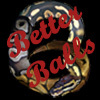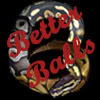» Site Navigation

1 members and 619 guests
Most users ever online was 47,180, 07-16-2025 at 05:30 PM.
» Today's Birthdays

» Stats

Members: 75,912
Threads: 249,118
Posts: 2,572,195
Top Poster: JLC (31,651)
Welcome to our newest member, coda
|
-
BPnet Veteran


Re: What do you think this is
Whew! I remember how confused I was when I first started learning about ball python genetics. I think one of the major confounding factors for new people is that there is sometimes a disconnect between what we as ball python people refer to a trait and what a geneticist would refer to a trait as. When I first started learning about ball python genetics, I got the impression that a 'het' as a normal looking animal that carries the allele for a recessive trait. Really though, an animal that is heterozygous from a genetics standpoint is just an animal with two different alleles (varying forms of a gene). Thus, the normal looking animals we typically refer to as 'hets' carry one normal allele and one recessive allele. For example, a het albino had one albino allele and one normal allele. It takes two copies of the albino allele for an animal to look albino though. Since the one normal allele masks the single recessive allele, the animal looks normal. At the same time, a pastel can be referred to as a heterozygous animal as well. A normal pastel carries one copy of the normal allele and one copy of the pastel allele. In this case, however, since the pastel allele is dominant to the normal allele, the animal is a pastel instead of a normal. You can't have a het for pastel, because any animal that doesn't look like a pastel does not carry a pastel allele. What we refer to as codominant mutations are mutations that, when present in two copies, shows a different expression than the single copy. Therefore, an animal with two copies of the pastel gene is a super pastel. In this case, having two copies of the gene 'ramps up' expression of the pastel trait. This is the same case with the mojave/lesser/butter complex, where two copies of any of those alleles gives the blue eyes lucy super. This gets even trickier when you run across mutations that are simply dominant, as Randy was referring to the pinstripe being. In this case, a heterozygous animal that carries one copy of the pinstripe allele and one copy of the normal allele looks like a pinstripe. At the same time, an animal with two copies of the pinstripe allele looks the same as an animal with one copy. By being a dominant trait, it means there is no difference in expression between the 'heterozygous' animal that carries one copy of the pinstripe allele and the 'homozygous dominant' animal that carries two copies of the pinstripe allele. As for the homozygous spider thing, I believe people think the homozygous spider is a lethal condition, meaning no homozygous spiders ever hatch out because something developmentally goes wrong early in development. At the same time, I think I remember someone saying they had heard of a male spider that always throws spider offspring. This would be a homozygous dominant spider. The problem is it is very hard to prove beyond a doubt you have a dominant spider or pinstripe. The animal will always have offspring that are spiders of pins, but you could also get that from a really 'lucky' heterozygous animals.
I hope this helps, and if I have said anything that sounds wrong someone please correct me. I am still fairly new to this myself. And if someone else could chime in on the homozygous spider issue, I know I am not up to date on that.
 Go NCSU Wolfpack!
Go NCSU Wolfpack!
-
The Following User Says Thank You to PythonChick For This Useful Post:
 Posting Permissions
Posting Permissions
- You may not post new threads
- You may not post replies
- You may not post attachments
- You may not edit your posts
-
Forum Rules
|











 Reply With Quote
Reply With Quote